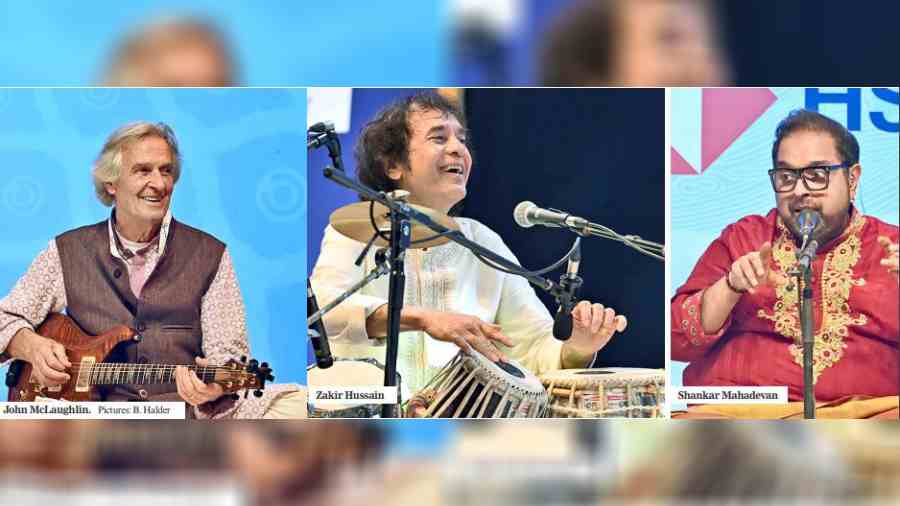It’s all about energy, as the name ‘Shakti’ suggests. There is a reason why Shakti is a household name, and there is a reason why these musicians are living legends. And Calcutta was fortunate enough to witness just that — forces of a cosmic nature coming together to create spontaneous magic out of thin air, and spreading the universal language of peace, love and devotion. After three long years, Shakti returned to the City of Joy on January 24 to perform their third concert (as part of Tata Steel Kolkata Literary Meet in association with The Telegraph) of their 50th anniversary tour of India, after Bengaluru and Mumbai. At the end of the performance, the 3,000- plus audience at the Calcutta Cricket and Football Club ground was left mesmerised and fulfilled, but with a sense of longing for more, as if it all ended too soon.
The concert began with the line-up that featured John McLaughlin on electric guitar, Ustad Zakir Hussain on tabla and additional percussions, Ganesh Rajagopalan on violin and V. Selvaganesh on kanjira, mridangam and ghatam. The band took the entire arena by storm with their first two tunes, the first tune (which is a composition from the ‘90s) featuring a blistering violin solo by Rajagopalan, with machine gun-like precision firing impeccable melodic passages one after the other. Needless to say that just the mere presence of John McLaughlin and the aura that he exuberates on stage was enough to capture anybody’s attention. He was playing a Paul Reed Smith Guitar, and the sheer sound and tone of it were perfect and serene. I loved McLaughlin’s bluesy style that was very evident in his playing that night, of course, intertwined with his evergreen signature style of rhythmic phrases, impeccable melodies, uncanny sense of time and divine execution.
The third tune introduced Shankar Mahadevan on vocals, and they performed a Carnatic kriti (a traditional format of musical composition typical to Carnatic music), followed by a North Indian thumri called Sakhi, which is one of the band’s wellknown compositions. Shankar was beautiful, fluid and absolutely on point with his deliveries. But once again, I was stunned by McLaughlin’s brilliance — the way he played backup during Shankar Mahadevan’s adlib aalap-styled improvisation; his guitar sound (which went through his laptop) had a lush keyboard pad layered underneath the guitar tone, and he played all these beautiful chords from the jazz realm, and all of it made perfect sense and completely in context to the Indian roots of the composition. Sakhi had a section which introduced an electronic drum-n-bass style rhythm loop at a pretty high tempo, and the whole band were locked in tandem together in a fiery yet serene energy.
Next up was a favourite of mine, Five Peace Band, which featured Selvaganesh on the ghatam, and every time you hear this tune, live or recorded, you will find something new to discover. The band was seamless, and there was a really interesting sawaal-jawaab between Zakirji and Selvaganesh on a time cycle of five beats, but using their vocal konnokol recitation rather than their instruments, which I found very cool (the percussion maestros saved something extraordinary for later, which I will come to).
The band then played Bridge of Sighs. Wrapped in a haunting melancholic melody, this tune from 1976 is a favourite amongst dedicated followers of the band. This was followed by a tune called Kikee, which I heard for the first time. This was a really quirky tune, with McLaughlin starting out with a straight-up blues riff on a shuffle rhythm, but on a time cycle of seven beats. Shankar Mahadevan hit the perfect notes with vocal flourishes, and Rajagopalan’s violin cut through seamlessly from the ground laid by McLaughlin’s masterful guitar embellishments. Needless to say, what amazes me is the way the band incorporates styles from different spheres, different cultures and traditions, but maintains such a strong identity as a unique ensemble.
Then came the Magnum Opus of the night — Finding the Way. Easily the highlight of the concert for me, this tune on a cycle of 12 beats featured extended solos from Selvaganesh and Zakir Hussain. Selvaganesh was on fire, with his epic Kanjira recital. His technical grasp over the instrument was only matched by his poetry, and what we witnessed was musical storytelling at its highest level. Following his solo was Ustad Zakir Hussain’s story. The way he built on his tabla feature was nothing short of wizardry, and we witnessed a painting manifest itself through beauty, aesthetics and decades of experience — truly a master of the art of rhythmic improvisation. This was supposed to be their last tune for the night, but obviously, the audience couldn’t get enough of the magic and Shakti provided us with an encore, their evergreen composition Lotus Feet.
The concert was an experience that we will definitely remember and cherish for the rest of our lives, and I believe that we witnessed history — the 50th year of this groundbreaking vision and sound. What is truly exceptional and unique about these legends is that not only have they mastered such a difficult and challenging form of music with their years of dedication, experience and saadhana, but the way they present it is so fluid that it is an absolute delight to the ears of the listener, and provides a thoroughly refreshing and beautiful listening experience. Most importantly, I think what all of us can absorb and learn from them is the message that they spread through their music. The message of love, unity and peace. Such is the power of music, and such is the Shakti — the energy that binds the universe together.
